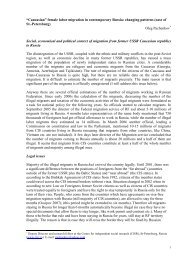THORIUM AS AN ENERGY SOURCE - Opportunities for Norway ...
THORIUM AS AN ENERGY SOURCE - Opportunities for Norway ...
THORIUM AS AN ENERGY SOURCE - Opportunities for Norway ...
You also want an ePaper? Increase the reach of your titles
YUMPU automatically turns print PDFs into web optimized ePapers that Google loves.
Nuclear Reactors <strong>for</strong> Thorium<br />
result in a slow coolant heat-up. This should normally lead to a manual shutdown. Fast and<br />
rather large reactivity insertions (which are of very low probability in a system without control<br />
rods) lead only to a limited power increase. This is due to the subcriticality of these systems. To<br />
stop such a limited overpower condition, a beam shut-off or the insertion of safety rods is<br />
necessary. The switching off of an accelerator is principally simpler than the insertion of safety<br />
rods.<br />
5.4.4.6 Advantages of the ADS<br />
Due to its special design, an ADS has some advantages when compared to more standard<br />
reactors.<br />
1. The main advantage of an ADS is the subcriticality of the core. This gives an improved margin<br />
to prompt criticality leading to a runaway reactor like the Chernobyl reactor. However, this<br />
kind of reactivity-induced accident is highly improbable in modern nuclear power reactors,<br />
since they are constructed with negative power reactivity coefficients. This means that the<br />
reactivity decreases when the power increases, thus limiting power excursions. The Chernobyl<br />
reactor, on the other hand, had positive power reactivity coefficients, which lead to a rapidly<br />
accelerating power increase.<br />
2. The largest benefit of the subcriticality is that it facilitates a more effective way of<br />
transmuting the minor actinides. The control of traditional reactors depends to a large extent<br />
on a small fraction of the neutrons emitted in the fission process that are delayed, varying<br />
from a few tenths of a second up to around 1 minute. For U-235 the delayed fraction of<br />
neutrons is 0.65 %, and this prevents rapid power increases <strong>for</strong> reactivity insertions less than<br />
0.65 %. However, many of the minor actinides (Np, Am, Cm ...) as well as U-233 have lower<br />
delayed neutron fractions than U-235. If a substantial amount of minor actinides or U-233 is<br />
added to the reactor fuel, it will inevitably lead to a significantly reduced margin to prompt<br />
criticality. This problem does not exist <strong>for</strong> an ADS because the reactivity of the core can be<br />
reduced with an amount corresponding to the reduced margin to prompt criticality, at the cost<br />
of increasing the accelerator power to keep the power constant.<br />
3. The production of long-lived actinides (Np, Pu, Am, Cm ...) is much smaller than <strong>for</strong> a<br />
conventional reactor fuelled with low-enriched uranium. The storage time <strong>for</strong> the waste may<br />
there<strong>for</strong>e be shortened from several tens of thousands of years to less than a thousand years.<br />
Here it should be mentioned that the storage time of waste from the fourth generation of<br />
reactors also will be significantly reduced compared with today’s reactors, since actinide<br />
separation and recycling will be an integrated part of the fuel cycle.<br />
4. The absence of control rods may simplify reactor control, since the power is proportional to the<br />
accelerator power. In any pressurized reactor system the penetrations of the control rods<br />
through the reactor vessel are possible leakage paths from the primary system. There is also a<br />
small possibility of control rod ejection, which would lead to a rapid reactivity increase.<br />
5. Due to the high boiling point of the lead-bismuth eutectic (1670 °C), the pressure above the<br />
core can be kept at, or close to, atmospheric pressure. Low pressure reduces the risk of<br />
ruptures in the Cover Gas System (CGS). Of course, in the lower part of the reactor tank the<br />
pressure will be higher (≈ 28 bars) due to the 25 meters of lead. This is still much less than the<br />
160 bar pressure used in the present generation of pressurized water reactors.<br />
65

















